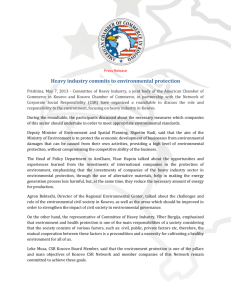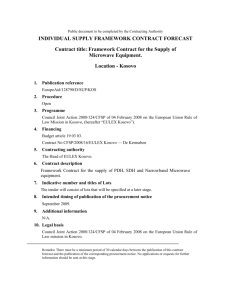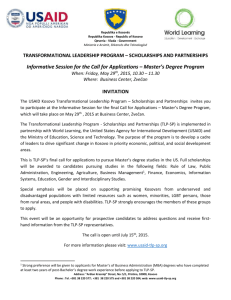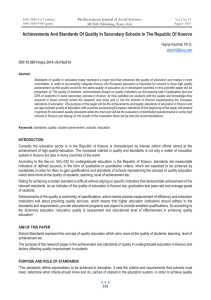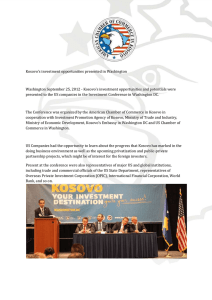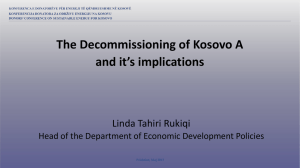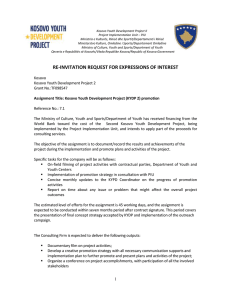THE NEEDS OF TRAINING AND DEVELOPMENT OF HUMAN RESOURCES FOR... ORGANIZATION THE CASE OF COMPANIES IN KOSOVO
advertisement
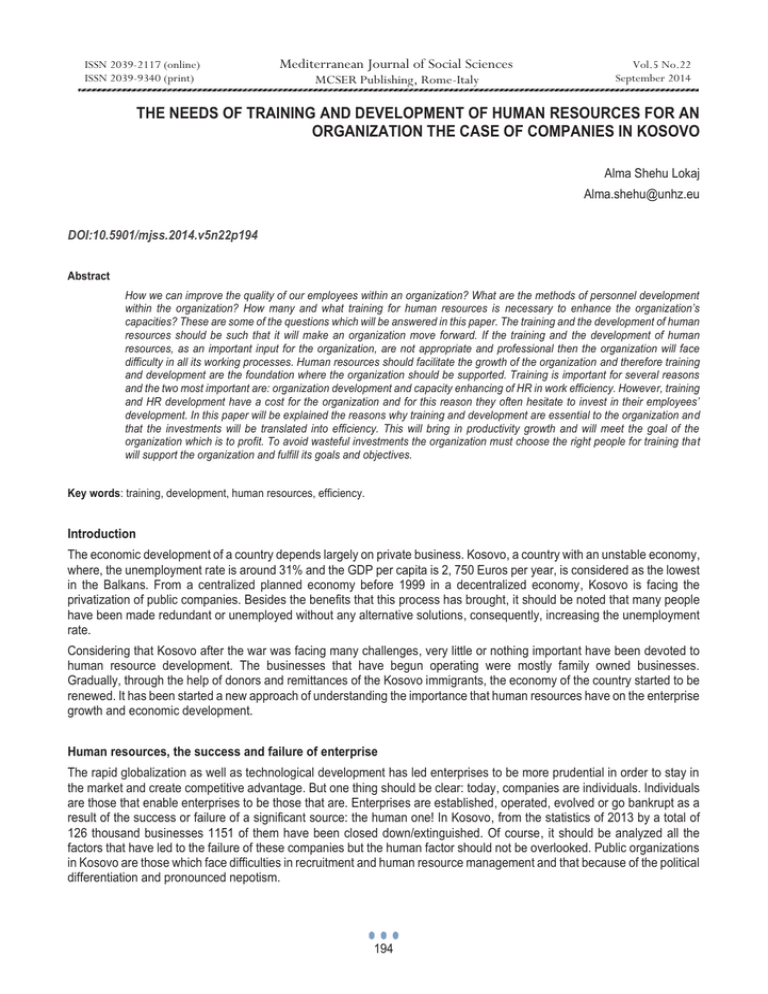
ISSN 2039-2117 (online) ISSN 2039-9340 (print) Mediterranean Journal of Social Sciences MCSER Publishing, Rome-Italy Vol.5 No.22 September 2014 THE NEEDS OF TRAINING AND DEVELOPMENT OF HUMAN RESOURCES FOR AN ORGANIZATION THE CASE OF COMPANIES IN KOSOVO Alma Shehu Lokaj Alma.shehu@unhz.eu DOI:10.5901/mjss.2014.v5n22p194 Abstract How we can improve the quality of our employees within an organization? What are the methods of personnel development within the organization? How many and what training for human resources is necessary to enhance the organization’s capacities? These are some of the questions which will be answered in this paper. The training and the development of human resources should be such that it will make an organization move forward. If the training and the development of human resources, as an important input for the organization, are not appropriate and professional then the organization will face difficulty in all its working processes. Human resources should facilitate the growth of the organization and therefore training and development are the foundation where the organization should be supported. Training is important for several reasons and the two most important are: organization development and capacity enhancing of HR in work efficiency. However, training and HR development have a cost for the organization and for this reason they often hesitate to invest in their employees’ development. In this paper will be explained the reasons why training and development are essential to the organization and that the investments will be translated into efficiency. This will bring in productivity growth and will meet the goal of the organization which is to profit. To avoid wasteful investments the organization must choose the right people for training that will support the organization and fulfill its goals and objectives. Key words: training, development, human resources, efficiency. Introduction The economic development of a country depends largely on private business. Kosovo, a country with an unstable economy, where, the unemployment rate is around 31% and the GDP per capita is 2, 750 Euros per year, is considered as the lowest in the Balkans. From a centralized planned economy before 1999 in a decentralized economy, Kosovo is facing the privatization of public companies. Besides the benefits that this process has brought, it should be noted that many people have been made redundant or unemployed without any alternative solutions, consequently, increasing the unemployment rate. Considering that Kosovo after the war was facing many challenges, very little or nothing important have been devoted to human resource development. The businesses that have begun operating were mostly family owned businesses. Gradually, through the help of donors and remittances of the Kosovo immigrants, the economy of the country started to be renewed. It has been started a new approach of understanding the importance that human resources have on the enterprise growth and economic development. Human resources, the success and failure of enterprise The rapid globalization as well as technological development has led enterprises to be more prudential in order to stay in the market and create competitive advantage. But one thing should be clear: today, companies are individuals. Individuals are those that enable enterprises to be those that are. Enterprises are established, operated, evolved or go bankrupt as a result of the success or failure of a significant source: the human one! In Kosovo, from the statistics of 2013 by a total of 126 thousand businesses 1151 of them have been closed down/extinguished. Of course, it should be analyzed all the factors that have led to the failure of these companies but the human factor should not be overlooked. Public organizations in Kosovo are those which face difficulties in recruitment and human resource management and that because of the political differentiation and pronounced nepotism. 194 ISSN 2039-2117 (online) ISSN 2039-9340 (print) Mediterranean Journal of Social Sciences MCSER Publishing, Rome-Italy Vol.5 No.22 September 2014 Many companies are clear on how to achieve financial benefits, refine machinery and equipment but, when it comes to personnel is an own story behind. It is noted that many companies rarely encourage employees as partners in their business; on the contrary, their behaviors are controlled. If human resources are taken and treated seriously then, the company will take another direction, certainly a positive one. Sometimes, the important issue for an organization is not employing a talent or finding the best possible training but the most important is the handling and considering the individuals as part of the organization and as a source of competitive advantage. Claiborne (2009) stated that the poor management of human resources, marketing and business strategy are three key factors in the failure of small businesses. Human resources are distinguished from other sources that may have an organization. Other resources of the organization can be purchased, stored or deleted at any time but, the human resources need special handling or treatment. Moreover, according to Muhammed, Bhati and Jariko (2013, pg. 129-130) other sources can be depreciated over time but the human resources gain experience and become more profitable for the organization. From the economic perspective, the accumulation of human capital and the effective use of it lead to facilitate the process of economic development. If companies will use their resources efficiently then, this would lead to achieving their objective, that is profit. Many enterprises in Kosovo give special importance to the technology and equipment they use often leaving aside those who use this technology or equipment, the human factor. This deficiency is noticed that the recruitment process, especially, to the public companies and less to private business where, development interest and profit is greater. One of the best methods in the development and advancement of human resources is also training. How much are training programs practiced in the Kosovo organizations? Are training programs targeted to the type and location of work? These are some issues which will be discussed below. Importance of Training in Human Resources Development It is now accepted by all the outstanding fact that training is planned efforts of the organization to enable the acquisition of competencies associated with the job competencies. While, the development includes formal education, work experience, interrelation and evaluation of personality and abilities that help employees to prepare for successful work in the future. Everyone can affirm the fact that each organization intends to recruit individuals who are qualified as well as adjusted, employees that mostly respond to demands and terms set by the organization. In the tables below it is indicated some data from an observation that has been done at about 500 small businesses operating in Kosovo, that presents the statute of employment percentage and training, experience and consultancy services. Table 1: SME employment status by percentage Description % share of number of employees Full time employees 92.2 Permanent part time employees 1.1 Seasonal employees – with contract 5.1 Seasonal employees without contract Total 1.7 100.0 Source: Source: BSCK SME Survey, 2010 195 Mediterranean Journal of Social Sciences ISSN 2039-2117 (online) ISSN 2039-9340 (print) Vol.5 No.22 September 2014 MCSER Publishing, Rome-Italy From the observation it can be seen that a large percentage of employees (92.2%) in these businesses and the other percentage belongs to the other ways of employees. What makes an impression on this table is the seasonal employment without a contract. This shows the great need of individuals to work even without a contract. Table 2: Training, experience and consultancy services Responses Yes No Total Have you or your mangers attended any training in the area of management and business? Have you or your Have you used any type mangers ever worked in a managerial position before joining this company? of consultancy from other (%) (%) 24.3 22.8 institutions/organizations? (%) 13.6 75.7 77.2 86.4 100.0 100.0 100.0 Source: BSCK SME Survey 2010. Training of employees is an integral part of human resources development at both the managerial and non-managerial level. The findings of BSCK are as follow: only 24 percent of SME managers have completed some type of training for management and business practice (Table 2). In addition is observed an even smaller proportion of them that have managers with previous managerial experience in other organizations. Training of employees is an integral part of human capital development at both the managerial and non-managerial level. From the survey findings we observed that only 24 percent of SME managers have completed some type of training for management and business practice (Table 2). In addition is observed an even smaller proportion of them that have managers with previous managerial experience in other organizations (Business Support Centre Kosovo (2011) “Entrepreneurship and small business development service in Kosovo” Research Report”). Regarding the consultancy services that SMEs in Kosovo make use of, is observed unsatisfactory results as only 13.6 percent of enterprises declared that they receive some type of consultancy services from other organizations. SMEs seem to enjoy only limited benefits from consultancy. If we compare the small percentage of firms that have experienced managers and also the small portion of them that have received management training, it becomes more obvious that SMEs should make more efforts to contract complementary skills form external consultants in order to increase managerial capabilities. However, from companies that received consultancy, only 46 percent were satisfied with the quality of consultancy services, raising questions about the quality of consulting firms in Kosovo. From the observations done by the Business Support Centre Kosovo (2011), it is seen obviously that less importance is given to training human resources in organizations. As mentioned above on many private businesses have a primary objective of which is profit. Thus, mainly everyone believes in profit and still have not clear that this is a short-term objective and because of this they are reluctant to invest in training and staff development, considering this as a cost as well as waste of time for the enterprise. Hence, one of the main goals of this paper is to understand the importance of training in staff development, because, it is the only way that will provide enterprise sustainability and competitive advantage in the market. Phillips’s (1996, pg 42-47) summary of the American Society for Training and Development’s Return on Investments for training case studies in a variety of industries notes that the returns on investment ranged from 150% to 2000%. The purpose of training always is improving the capacity of employees and thus, the capacity of the organization. However, to be effective, initially, the organizations need to do training needs analysis and financial costs and the time dedicated to them should be closely associated with the mission and vision of the organization. Donald Kirkpatrick, Professor Emeritus at the University of Wisconsin and past president of the American Society for Training and Development 196 ISSN 2039-2117 (online) ISSN 2039-9340 (print) Mediterranean Journal of Social Sciences MCSER Publishing, Rome-Italy Vol.5 No.22 September 2014 (ASTD), first published his Four-Level Training Evaluation Model in 1959, in the US Training and Development Journal. The model was then updated in 1975, and again in 1994, when he published his best-known work, "Evaluating Training Programs." The four levels are: Reaction; Learning; Behavior; Results. He also explained each level in greater detail. Level 1: Reaction This level Measures how your trainees (the people being trained), reacted to the training. Obviously, you want them to feel that the training was a valuable experience, and you want them to feel good about the instructor, the topic, the material, its presentation, and the venue. It's important to measure reaction, because it helps you understand how well the training was received by your audience. It also helps you improve the training for future trainees, including identifying important areas or topics that are missing from the training. Level 2: Learning At level 2, you measure what your trainees have learned. How much has their knowledge increased as a result of the training? When you planned the training session, you hopefully started with a list of specific learning objectives: these should be the starting point for your measurement. Keep in mind that you can measure learning in different ways depending on these objectives, and depending on whether you're interested in changes to knowledge, skills, or attitude. It's important to measure this, because knowing what your trainees are learning and what they aren't will help you improve future training. Level 3: Behavior At this level, you evaluate how far your trainees have changed their behavior, based on the training they received. Specifically, this looks at how trainees apply the information. It's important to realize that behavior can only change if conditions are favorable. For instance, imagine you've skipped measurement at the first two Kirkpatrick levels and, when looking at your group's behavior, you determine that no behavior change has taken place. Therefore, you assume that your trainees haven't learned anything and that the training was ineffective. However, just because behavior hasn't changed, it doesn't mean that trainees haven't learned anything. Perhaps their boss won't let them apply new knowledge. Or, maybe they've learned everything you taught, but they have no desire to apply the knowledge themselves. Level 4: Results At this level, you analyze the final results of your training. This includes outcomes that you or your organization have determined to be good for business, good for the employees, or good for the bottom line. Training investment returns for the company Motorola calculated that every dollar spent on training yields an approximate 30 percent gain in productivity within a threeyear period. Motorola also used training to reduce costs by over $3 billion and increase profits by 47 percent (source: Tim Lane et al., "Learning to Succeed in Business with Information Technology, " Motorola). Career development is considered as the No.1 factor in keeping employees in the company according to a survey of 6, 400 employees conducted by Sharon Jordan Evans and Beverly Kaye. Another study "100 Best Companies to work-with" shows that the best companies in the world make significant investments in training programs, thus, providing 665 hours of annual training for staff and 53 hour training for others. From these training hours, almost 70% is devoted to the current roles/positions of the employees and 30% is focused on growth and development. However, it should be noted that the training resources tend to be more abundant when the company performed well but in periods of economic hardship tends to be the first to be interrupted. Identify training needs and training grounds failures in Kosovo companies From Table 2 it has been seen how much importance is given to training in Kosovo companies and it is concluded that one of the reasons why most of these companies do not succeed is because of lack of organizing training and staff development. 197 ISSN 2039-2117 (online) ISSN 2039-9340 (print) Mediterranean Journal of Social Sciences MCSER Publishing, Rome-Italy Vol.5 No.22 September 2014 Kosovo companies intend to grow and to be equal with companies of the developed countries and to achieve this one of the strategies that they should use are training of the new and existing staff in the company. Before starting the training process companies need to make a careful analysis to identify training needs. But what are the reasons why the staff is trained and developed? For the reason that: - Jobs and technology change; - New staff/recruit needs special training; - Promoted staff needs to be equipped with innovative skills; - Impact on increasing motivation and continuing their work; - Increases efficiency of staff; - Improves the career development of staff; How a company can identify training needs? According to Pigors and Myers (1983:283) the types of employee training best suited to a specific organization depend upon a number of factors such as skills called for in jobs to be filled, qualifications of candidates applying for jobs, and the kinds of operating problems confronted by the organization… In my opinion, it would be more appropriate the existing employees to identify their needs, because they best know their strengths and weaknesses. Nevertheless, there are other methods that will assist the company in identifying training needs: New employees/recruit can be identified by interview or working for a short time on the relevant job; Older employees based on their performance in the existing work. Some of the reasons of trainings failure Thousands of hours and money are spent each year creating training that doesn’t work. How can this be? There are three primary reasons according to Nanette Miner: The training is created by individuals with limited experience and background in the field of training and development. The training is created by subject matter experts. The training is designed without clearly thought-out objectives. Let us explain each of the training failure reasons in Kosovo companies: The first reason: because of the lack of experience in training field in Kosovo the trainings are held by persons that are experts in different fields, for example if a person was good as sales manager than this person trained the others the same with the manger of marketing and so on. For this reason a big number of training failed. However, in the last years has been noticed a trend, this as a consequence of the companies’ growth, to train the employees out of the country or to bring to the company international and professional trainers. Albeit (1985) dated the most recent research regarding the education of training professionals discovered that less than eight percent of us have formal education in the field of human resource development. The preponderance of degrees are in the field of primary education. Furthermore, many trainers don’t realize that the mother of training and development is adult learning theory--and scant few individuals have any exposure to adult learning theory and methodology. For example, there are six primary principles of adult learning theory, these are: Adults have a need to know why they should learn something. Adults have a need to be self directed. Adults have a broad range of life experience from which to draw and contribute. Adults become ready to learn when their life situation creates a need to know or need to be able to do in order to be able to perform more effectively and satisfyingly. Adults enter into a learning experience with a task-centered or problem-centered orientation to learning. Adults are motivated to learn more by intrinsic, rather than extrinsic (grades, raises) motivators. (Knowles) 198 ISSN 2039-2117 (online) ISSN 2039-9340 (print) Mediterranean Journal of Social Sciences MCSER Publishing, Rome-Italy Vol.5 No.22 September 2014 Training designed by subject matter experts spells disaster in one of two ways: Basic information is left out because the subject matter expert does not recognize what basic means anymore, or The subject matter expert is so hot on their topic that every possible nuance of the topic is included in the training. Certainly, if the company is cautious and does not make the abovementioned mistakes, then the training will be considered successful and the company will achieve its objectives. Another reason why the companies in Kosovo fail in training is because they hesitate to invest in trainings. These companies are not aware of the consequences: the best employees will leave if the company isn’t invested in their future. As best said by Lang, money is no longer motivating the workforce. Instead, it’s training and development. In this millennium, employees are focused on advancement and want to know, “How will this company help me? How will this training help me reach my career goals?” A company that invests in training will be able to retain their best-performing employees, along with all the benefits associated with long term company retention, including lack of retraining based on decreased turnover and increased performance levels. Lang reasons if you’re serious about doing amazing things and having a performance, culture, and training is the most obvious part of successfully competing in the marketplace or workforce. If the Kosovo companies are interested in competing in national or international level, than the key to be a serious player is investing in the future of the workforce. Progressing forward with the tools of yesterday can result in expensive losses, including lack of communication, losing key accounts and disastrous mistakes. Organizations should support training as a means of ensuring high performance levels, in order to maintain competitiveness in the private sector and efficient operations in the government. Kersten1explains that training is a critical part of key strategies, such as employee development, retention and implementing new initiatives, all of which relate to organizational performance. Conclusion and recommendations Kosovo companies after a difficult economic and political situation of 90’ entered in a new era of their development. Many of these companies survived the situation and others started from the beginning. The needs were big and initially they gave less importance to human resources. After the emergency situation and a kind of country stability the companies started to seriously think about their employees and about their professional preparation. With the enlargement of these companies, the free and open market, entering of the new technologies….etc was necessary the need of human resources training. The employees within a company should be managed with different methods and techniques of those used earlier. In the case of Kosovo, despite the ease of finding workforce in the labor market, due to the high level of unemployment, some of our country's companies are starting to realize that they must make an effort to train and develop their employees will not leave from work, but will give their best The present paper aims to be a guide to those companies that are interested in their employees’ development and to take as a recommendation everything they consider useful. The companies that train and develop their staff are those companies which appreciate, support and promote learning and knowledge. These companies know how to keep their workforce with capacity and trained employees, as the success of a company depends on the longevity of all employees. In general plan are recommended necessary changes that will bring a direct positive impact on human resource management and these recommendations are: (1) if the company decide to train its employees than the company must choose the right experts of the field; (2) before starting with the training process the company should clearly identify the training needs; (3)The company should not hesitate to invest on training because all studies show that their return is multiple and training improves employee performance, training enhances company profits, training saves labor, training saves money, training improves a company's competitive edge, training increases worker productivity, training saves supervisory and administrative time and costs, training improves customer satisfaction, training improves employee satisfaction and retention. Margie Kersten is an Americas Learning Deployment Leader and Associate Director for Ernst & Young LLP. Kersten manages learning deployment for key initiatives of the Diversity & Inclusiveness team and oversees all learning and development for the Fraud Investigation & Dispute Services practice within Ernst & Young. In addition, she teaches classes on leadership and effective communication to a wide range of employees. Her goal is to make training meaningful for all employees, so they feel connected with each other and invested in teaming together for ptimum client results 1 199 ISSN 2039-2117 (online) ISSN 2039-9340 (print) Mediterranean Journal of Social Sciences MCSER Publishing, Rome-Italy Vol.5 No.22 September 2014 References Claiborne, Roland., (2009) Why poor management can lead to small business failure. Jan Muhammed, Mitho Khan Bhati, Ghulman Ali Jariko & Abdul Wahid Zehri: Importance of HR investments for organizations and economy: A critical Analysis. Journal of managerial Sciences Business Support Centre Kosovo (2011)., Entrepreneurship and small business development service in Kosovo, Research Report. Phillips, J.J (1996). ROI. The search for best practices. Training and Development, SO(2), pg. 42-47 Pigors, P. & Myers, C. A. (1983). Personnel Administration. A Point of View and a Method. London: McGraw-Hill International Book Company Kosovo Human Development Report, Private Sector and Employment, Prishtina, 2012 Tim Lane et al., "Learning to Succeed in Business with Information Technology, " Motorola Jim, Kirkpatrik & Wendy Kayser (2009). The Kirkpatrick Four LevelsTM: A fresh look after 50 years 1959 – 2099. April, 2009 http://coned.howardcc.edu/business_and_workforce_development/customized_training/ROI_for_customized_training.htm l seen 25.06.2014 http://www.trainingdr.com/articles/whytraining.htm seen 25.06.2014 200
